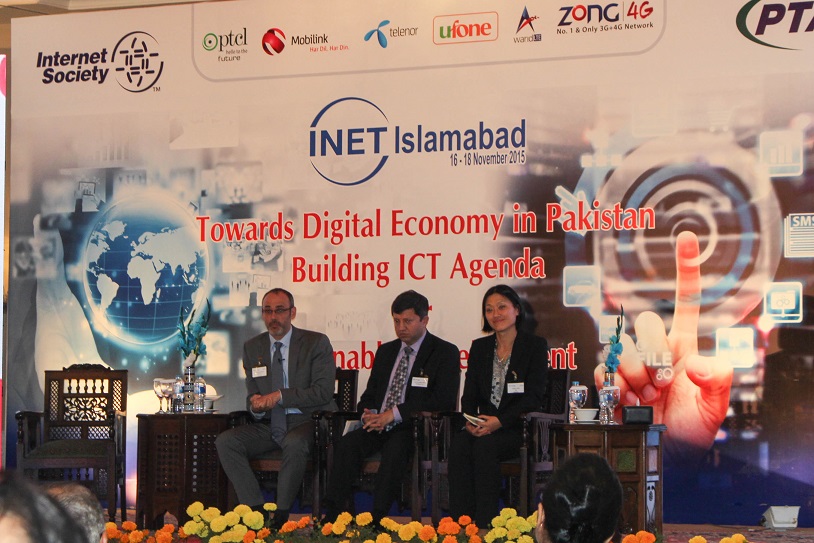ISLAMABAD (Pakistan) – Despite having the lowest Internet user density of 13.8% in the region, Pakistan has the potential to become the Internet transit hub for Central and South Asia, according a new study.
Pakistan’s geostrategic location and access to coastlines, offers the country great potential to become a supply route for the neighboring landlocked countries for Internet and communication services, said Rajnesh Singh, the Asia-Pacific head of ISOC.
Pakistan is the most populous country in the region, with the largest number of youth, which is an added advantage for Pakistan to become regional leader, he said speaking with the media.
The report synopsis highlights some of the opportunities along with some major challenges that are faced by the region and Pakistan specifically. The complete study will be released later this year, informed Yoonee Jeong, Research Director at TRPC.
The report titled ‘Unleashing the Potential of the Internet in Central Asia and Beyond: Pakistan in Focus’, was conducted by the Internet Society (ISOC) in association with the Asian Development Bank (ADB) and the United Nations Economic and Social Commission for Asia and the Pacific (UNESCAP).
Pakistan also has the highest international connectivity in the region at 300Gbps because of country’s coastline and direct access to submarine cable landing points.
Pakistan, along with Iran, (lying outside the Central Asia) has the potential to bridge access to international submarine cables and provide greater bandwidth to the whole region.
According to the report, internet penetration in the country is only 13 per cent.
But Dr. Syed Ismail Shah, Chairman, Pakistan Telecommunication Authority, disagrees. “The number of broadband users in Pakistan have exceeded to 20 million by now” he informed the participants. “The rising number of internet users will unleash the full potential of the Internet for building a digital economy in Pakistan.”
With over 30 million Internet users, half of which use the Internet over mobile, Pakistan is clearly an emerging market in the region.
The growth of the mobile network has helped dramatically improve voice-based communications services in the country, and deployment of the much-awaited 3G/4G networks have led to exponential growth in mobile broadband Internet in the past year or so. The challenge for Pakistan is to capitalize on these developments and move to the next stage in its evolution to a digital economy and help deliver its Vision 2025.
Matthew Perkins, Economic Affairs Officer at United Nations ESCAP, said “the greater internet connectivity can open up areas of socio-economic growth for Pakistan.”
Experts also highlighted that it is in Pakistan’s interest to enhance internet connectivity with all of its neighbours, China, Iran, Afghanistan and India.

Transitioning to Digital Economy
Through the adoption of effective and favorable policies by the government – and pursuing agreements with neighboring governments – Pakistan in the near future can find itself as an integral part of the supply chain to these countries. This will also allow it to enhance its own internal Internet bandwidth availability, and help pave the way for greater digitization of Pakistan’s own economy with growth, modernization and development in all sectors.
However, the report also underscores that the window of opportunity for Pakistan to position itself in this manner is finite. This presents a steep challenge for Pakistan but also allows an opportunity to integrate itself as an important part of the larger regional supply chain in the future.
Unleashing the Potential of the Internet in Central Asia and Beyond
The full report focuses on 10 countries – Afghanistan, Armenia, Azerbaijan, Georgia, Kazakhstan, Kirgizstan, Pakistan, Tajikistan, Turkmenistan and Uzbekistan – in the Caucuses and Central and South Asia. It focuses on Internet infrastructure and related issues.
The report is the third in a series of studies by ISOC that looks at sub-regional Internet ecosystems and their level of progress towards transitioning to a digital economy – where the Internet is the underlying driver of all sectors across an economy.
The Internet Society engages in a wide spectrum of Internet issues, including policy, governance, technology, and development. It aims to establish and promote principles that are intended to encourage governments to make decisions that are right for their citizens and each nation’s future. Organizational goals are based on ensuring that a healthy, sustainable Internet is available to everyone – today and for the next billions of users to come.

